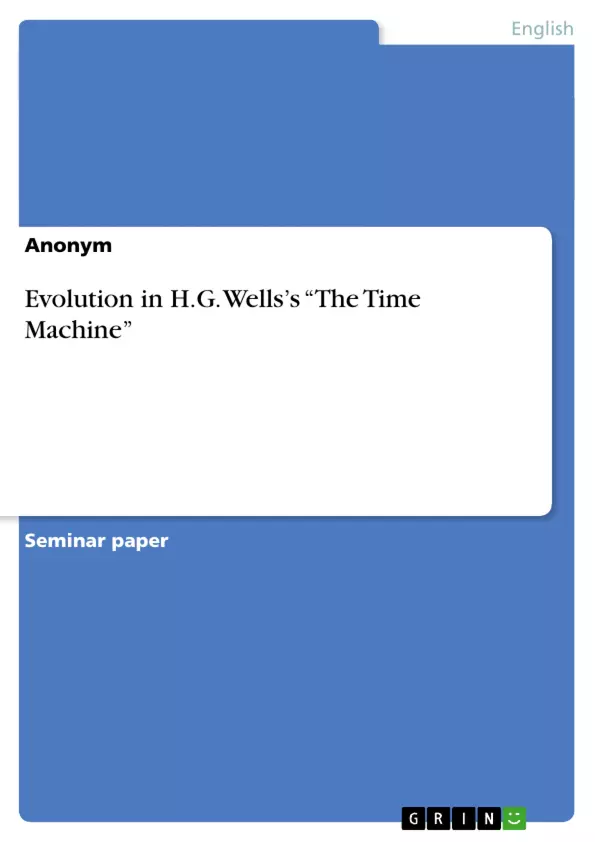H.G. Wells had been intrigued by speculations about the future progress of humanity towards a more equal society since his youth. (RUDDICK, 2007: 198) Studying at the Normal School of Science he came into contact with the mind-set of Thomas Henry Huxley who militated against the Social Darwinist thoughts which used evolutionary theories and were present in the late-Victorian society at the end of the 19th century. Huxley became an adored men-tor and friend for Wells who transferred and enhanced his ideas in his literature. (JANSING, 1977: 54)
The scientific romance The Time Machine, which was Wells’s first novel (GLENDENING, 2007: 7), explores the adventures of a respectable late-Victorian scientist within this evolutionary and Social Darwinist context. The scientist travels with his own created time machine into the year 802,701 where he finds the world of Eloi and Morlocks. These two species represent a degen-erated form of man whose retrogression results from socio-economic condi-tions. An additional journey 30 million years forward in time adds to the image of degeneration in the evolutionary process.
This research paper concentrates on the evolutionary and Social Darwinist theme of The Time Machine. First, an introduction to Social Darwinist thoughts in the end of the 19th century is given in order to set the context for this scien-tific romance. Secondly, the cognition process of the Time Traveller is analysed as this will make clear Wells’s examination with the social theories of his time. Studying selected symbols and images finally shows a detailed insight into the evolutionary subject of The Time Machine.
Inhaltsverzeichnis (Table of Contents)
- Introduction
- From Evolution to Social Darwinism in the Fin de siècle
- An analysis of "The Time Machine" in the context of Evolution and Social Darwinism
- The perception of the future world
- The Time Traveller's hypothesises about the descent of man
- The Time Traveller's attitude towards Eloi and Morlocks
- The arrival at the terminal beach
- An analysis of selected symbols and images
- Technology and the time machine
- The Sphinx and the rhododendron bushes
- The Palace of Green Porcelain
- The image of eating
- The perception of the future world
- Conclusion
Zielsetzung und Themenschwerpunkte (Objectives and Key Themes)
This research paper examines the evolutionary and Social Darwinist themes present in H.G. Wells's "The Time Machine." The paper aims to analyze the novel within the context of late 19th-century scientific and social ideas, exploring how Wells uses the story to comment on the potential consequences of evolutionary theory applied to social structures.- Evolutionary theory and its impact on social Darwinism in the late 19th century
- The Time Traveller's perception of the future world and his understanding of the Eloi and Morlocks as representing degenerated forms of humanity
- The role of symbolism and imagery in representing the themes of evolution and social decline within the novel
- The connection between technology and the time machine as a tool for exploring both the future and the consequences of human progress
- The potential for both positive and negative consequences of unchecked social and technological evolution
Zusammenfassung der Kapitel (Chapter Summaries)
- Introduction: This chapter introduces the novel "The Time Machine" by H.G. Wells and establishes the context for the analysis, emphasizing the novel's exploration of evolutionary and Social Darwinist themes within a late Victorian scientific context. The chapter introduces the Time Traveller's journey into the future, where he encounters the Eloi and Morlocks, species representing a degenerate form of humanity.
- From Evolution to Social Darwinism in the Fin de siècle: This chapter provides an overview of the social and intellectual context of late 19th-century society, specifically the impact of Charles Darwin's evolutionary theory on scientific and social thought. It explores the concept of Social Darwinism, which applied Darwin's principles of natural selection to social structures, and its influence on contemporary debates regarding class inequality, progress, and the future of humanity.
- An analysis of "The Time Machine" in the context of Evolution and Social Darwinism: This chapter delves into a detailed analysis of "The Time Machine," examining the novel's representation of evolutionary and Social Darwinist themes. It explores the Time Traveller's perceptions of the future world and his interpretations of the Eloi and Morlocks. The chapter also examines the significance of various symbols and images within the text, including the time machine, the Sphinx, the Palace of Green Porcelain, and the motif of eating.
Schlüsselwörter (Keywords)
The primary keywords and focus topics of this paper are: Social Darwinism, evolutionary theory, science fiction, H.G. Wells, "The Time Machine," degeneration, social decline, technology, symbolism, imagery, future, dystopia, fin de siècle. These terms encapsulate the core concepts and themes explored in the research, encompassing the novel's scientific and social commentary.- Arbeit zitieren
- Anonym (Autor:in), 2009, Evolution in H.G. Wells’s “The Time Machine”, München, GRIN Verlag, https://www.grin.com/document/138490



